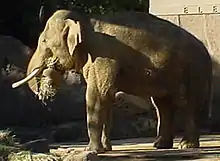Elephas
Elephas, hortumlular (Proboscidea) takımının günümüzde yaşayan iki fil cinsinden biridir. Cinsin soyu tükenmemiş tek türü ise Asya filidir Elephas maximus.[1]
| Elephas | ||||||||||||||||
|---|---|---|---|---|---|---|---|---|---|---|---|---|---|---|---|---|
 Asya fili (Elephas maximus) | ||||||||||||||||
| Bilimsel sınıflandırma | ||||||||||||||||
| ||||||||||||||||
|
Metne bakınız | ||||||||||||||||
Soyu tükenmiş türler arasında Elephas recki, Elephas antiquus, ve cüce filler E. falconeri ile E. cypriotes sayılabilir. Bu cins, mamut cinsi Mammuthus ile yakın akrabadır.[2]
Taksonomi
Elephas hortumlular (Proboscidea) takımının Filgiller (Elephantidae) familyasında sınıflandırılır ve yaşayan is assigned to the Proboscidean family Elephantidae and comprises one living and 10 extinct species:[3]
- Elephas maximus (Asya fili);[1]
- Elephas maximus indicus (Hint fili)
- Elephas maximus maximus (Seylan fili)
- Elephas maximus sumatranus (Sumatra fili)
- Elephas maximus borneensis (Borneo fili) — önerilmiş ancak henüz kabul edilmemiştir.[4]
- Elephas maximus rubridens (Çin fili) †
- Elephas maximus asurus (Suriye fili) †
- Elephas beyeri † — 1911 yılında Filipinler, Luzon'da bulunan fosil kalıntılarından von Königswald tarafından tanımlanmıştır;[5]
- Elephas celebensis, Sulawesi cüce fili † — 1949 yılında güney Celebes'te Hooijer tarafından tanımlanmıştır;[6]
- Elephas ekorensis † — Kenya'da Turkana'da Kubi Algi Formasyonunda tanımlanmıştır;[3]
- Elephas falconeri † — 1867 yılında Malta'da bulunan fosil kalıntılarından Busk tarafından tanımlanmıştır;[7]
- Elephas hysudricus † — 1845 yılında Siwalik tepelerinde bulunan fosil kalıntılarından Falconer ve Cautley tarafından tanımlanmıştır;[8]
- Elephas hysudrindicus † — Java Adası'nda bulunan Buzul Çağı'na ait ve Elephas maximus2tan farklı fosil fil;[9]
- Elephas iolensis †
- Elephas planifrons †
- Elephas platycephalus †
- Elephas recki †;[10][11]
Notlar
- Shoshani, J. (2005). ""Order Proboscidea"". Wilson, D. E.; Reeder, D. M. (Ed.). Mammal Species of the World (3rd ed.). Johns Hopkins University Press. s. 90. ISBN 978-0-8018-8221-0.
- Fleischer, R. C.; Perry, E. A.; Muralidharan, K.; Stevens, E. E.; Wemmer, C. M. (2001). Phylogeography of the Asian Elephant (Elephas maximus) based on mitochondrial DNA 17 Mart 2012 tarihinde Wayback Machine sitesinde arşivlendi.. Evolution 55(9): 1882–1892
- Maglio, V.J. (1973). Origin and evolution of the Elephantidae. Transactions of the American Philosophical Society Philadelphia Volume 63. American Philosophical Society, Philadelphia. Pp. 149
- Fernando, P., Vidya, T.N.C., Payne, J., Stuewe, M., Davison, G., et al. (2003). DNA Analysis Indicates That Asian Elephants Are Native to Borneo and Are Therefore a High Priority for Conservation 20 Mart 2008 tarihinde Wayback Machine sitesinde arşivlendi.. PLoS Biol 1 (1): e6
- Von Königswald, G. H. R. (1956). Fossil mammals from the Philippines. National Research Council of the Philippines, Manila
- Hooijer, D.A. (1949). Pleistocene Vertebrates from Celebes. IV. - Archidiskodon celebensis nov spec. 2 Kasım 2013 tarihinde Wayback Machine sitesinde arşivlendi.. Zoologische Mededelingen Museum Leiden, 30 (14): 205–226.
- Busk, G. (1867). Description of the remains of three extinct species of elephant, collected by Capt. Spratt, C.B.R.N., in the ossiferous cavern of Zebbug, in the island of Malta. Transactions of the Zoological Society of London, 6: 227–306.
- Falconer, H. Cautley, P. T. (1846). Fauna Antiqua Sivalensis, Being the Fossil Zoology of the Sewalik Hills 1 Ocak 2014 tarihinde Wayback Machine sitesinde arşivlendi.. Smith, Elder & Company, London. Pp. 64.
- Hooijer, D. A. (1955). Fossil Proboscidea from the Malay Archipelago and the Punjab 2 Kasım 2013 tarihinde Wayback Machine sitesinde arşivlendi.. Zoologische Verhandelingen, 28 (1): 1–146.
- Todd, N. E. (2001). African Elephas recki: Time, space and taxonomy 3 Kasım 2013 tarihinde Wayback Machine sitesinde arşivlendi.. In: Cavarretta, G., Gioia, P., Mussi, M. and M. R. Palombo. The World of Elephants, Proceedings of the 1st International Congress. Consiglio Nazionale delle Ricerche, Rome, pp. 693–697.
- Todd, N. E. (2005). Reanalysis of African Elephas recki: Implications for time, space and taxonomy. Quaternary International Volumes 126–128: 65–72.
This article is issued from Wikipedia. The text is licensed under Creative Commons - Attribution - Sharealike. Additional terms may apply for the media files.
